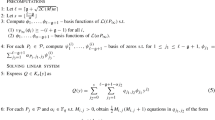Abstract
In the present paper, we investigate the existence of lattice perfect codes when considered as sublattices of other lattices under the Euclidean metric. We discuss the connection between a discrete tiling of a lattice and a continuous tilling of the n-dimensional space and equivalent characterizations of discrete tilings. We generalize bounds on the radius of perfect codes in a generic lattice, which were previously known for the cubic lattice, and we provide some new bounds. The new bounds are based on the packing and the covering densities and on the covering radius of the ambient lattice. An algorithm is presented for the search of perfect codes which is used to derive all perfect codes for a collection of ambient lattices in dimensions two and three. In contrast to the cubic lattice, these case studies show that by considering general ambient lattices one can find rich sets of perfect codes.





Similar content being viewed by others
References
Araujo C, Dejter I, Horak P (2014) A generalization of Lee codes. Des. Codes. Crypt. 70:77–90
Araujo C, Dejter I (2014) Lattice-like total perfect codes. Discussiones Mathematicae. Graph Theory 34(1):57–74
Campello A (2018) Random ensembles of lattices from generalized reductions. IEEE Trans. Inf. Theory 64(7):5231–5239
Campello A, Jorge GC, Strapasson JE, Costa SIR (2016) Perfect Codes in the \(l_{p}\) metric. Eur. J. Comb. 53:72–85
Conway JH, Sloane NJA (1998) Sphere Packings, Lattices and Groups. Springer, New York
Costa SIR, Muniz M, Agustini E, Palazzo R (2004) Graphs, Tessellations, and Perfect Codes on Flat Tori. IEEE Trans. Inf. Theory 50(10):2363–2377
Dejter I, Fuentes L, Araujo C (2018) There is but one PDS in \(\mathbb{Z}^3\) inducing just square components. Bull. Inst. Comb. Appl. 82:2–13
Etzion T, Vardy A, Yaakobi E (2010) Dense error-correcting codes in the Lee metric. In: 2010 IEEE Information Theory Workshop, Dublin 1–5
Golomb SW, Welch LR (1970) Perfect Codes in the Lee Metric and the Packing of Polyominoes. SIAM J. Appl. Math. 18(2):302–317
Horak P, AlBdaiwi BF (2012) Diameter perfect Lee codes. IEEE Trans. Inf. Theory 58(8):5490–5499
Horak P, Grosek O (2014) A new approach towards the Golomb-Welch conjecture. Eur. J. Comb. 38:12–22
Kim D (2017) Nonexistence of perfect \(2\)-error-correcting Lee codes in certain dimensions. Eur. J. Comb. 63:1–5
Kolountzakis M (1998) Lattice tillings by cubes: whole, notched and extended. Electron. J. Comb. 5(1):R14,11
Kolountzakis M (1997) Lattice-tiling properties of integral self-affine functions. Appl. Math. Lett. 10(5):1–4
Kovacevic M (2016) Codes in \(A_n\) Lattices: Geometry of \(B_h\) Sets and Difference Sets. preprint available at arXiv:1409.5276v4
Lagrarias JC, Wang Y (1996) Integral self-affine tiles in \(\mathbb{R}^n\) I. Standard and nonstandard digit sets. Lond. Math. Soc. 54:161–179
Lagrarias JC, Wang Y (1997) Integral self-affine tiles in \(\mathbb{R}^n\) part II. Lattice tilings. J. Fourier Anal. Appl. 3:83–102
Qureshi C, Campello A, Costa SIR (2018) Non-existence of linear perfect Lee codes with radius \(2\) for infinitely many dimensions. IEEE Trans. Inf. Theory 64(4):3042–3047
Sole P (1995) Counting lattice points in pyramids. Discrete Math. 139:381–392
Sok L, Belfiore J, Solé P, Tchamkerten A (2018) Lattice codes for deletion and repetition channels. IEEE Trans. Inf. Theory 64(3):1595–1603
Strapasson JE, Jorge GC, Campello A, Costa SIR (2018) Quasi-perfect Codes in the \(l_{p}\) metric. Comp. Appl. Math. 37:852–866
Strey GRAS (2020) Còdigos Perfeitos e Ladrilhamentos em Diversos Reticulados Ambientes. PhD Thesis, University of Campinas
Strey G, Campello A, Strapasson JE, Costa SIR (2019) Perfect codes in Euclidean lattices: bounds and case studies. In: 2019 IEEE International Symposium on Information Theory (ISIT). Paris, France, pp. 1607–1611. https://doi.org/10.1109/ISIT.2019.8849538
Acknowledgements
The authors would like to thank the reviewers for their very pertinent comments and suggestions. The authors also are thankful to the support of the CNPq (313326/2017-7, 141343/2019-2, 432735/2016-0 and 429346/2018-2) and FAPESP (2013/25977-7) foundations.
Author information
Authors and Affiliations
Corresponding author
Additional information
Communicated by Thomas Aaron Gulliver.
Publisher's Note
Springer Nature remains neutral with regard to jurisdictional claims in published maps and institutional affiliations.
Rights and permissions
About this article
Cite this article
Strey, G., Strapasson, J.E. & Costa, S.I.R. Perfect codes in Euclidean lattices. Comp. Appl. Math. 40, 47 (2021). https://doi.org/10.1007/s40314-021-01436-3
Received:
Revised:
Accepted:
Published:
DOI: https://doi.org/10.1007/s40314-021-01436-3




